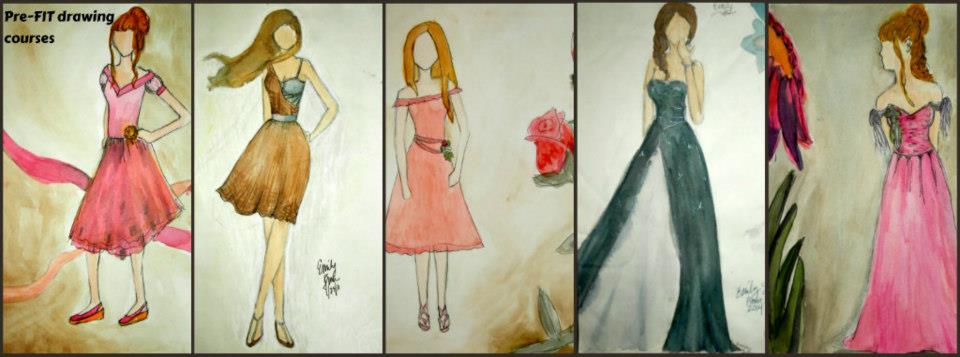Hey everybody! It’s Emily, the blogger from last fall with the chickens and the hurricane. I actually just moved back home, and the chickens are back in their coop in the backyard.
Putting together a fashion design application portfolio is not the easiest task. Especially while juggling AP classes, homework, fine arts portfolios and costumes for two plays at school at the same time. Thankfully, I have my own room with a desk to work on everything, and the portfolio class on Saturday mornings, where I can work on projects specific to the application.
But putting together a portfolio is also a chance to reflect on my work from the past four years of programs, and while there isn’t much of a change to the feeling conveyed by my drawings, there is a definite improvement in technique. Before I came to class, I worked only in watercolor, and I couldn’t get the proportions right or really show that the clothes were separate from the figure. When I had to use the art markers, I was scared of them. I didn’t like the way I couldn’t control them, but it was easier to render the different fabrics.
By now, the fall 2013 semester, I have learned a lot of little tricks that add up to more accurate renderings, like having a tucked shirt bulge where it meets the waistband, or showing the different layers of fabric when pockets have been appliqued on. Another big thing is showing shadows- don’t be afraid of contrast! Fabric doesn’t lay flat on a body, it has curves and bumps and hills and valleys that all catch light and cast shadows. Folds happen too. Try to draw them, especially if an elbow or knee is bent. It adds another dimension to the drawing. Wrinkles happen when fabric is gathered, and all that is is an extra shadow. And all that’s just from asking questions and observing what was fixed in my drawing classes!
 Sewing is another beast entirely, because with fabric, you can’t really force it to do something it’s not capable of without working with it. Soft, flowy fabrics aren’t going to stand up straight without being fused to a stiff backing, and stiff fabrics aren’t going to drape like a softer one. Wovens will not stretch as much as knits will. Zippers are an ordeal to set, and hemming a circle skirt is not the easiest task in the world. I think everyone’s made the mistake of forgetting to add their seam allowance at least once, and ended up with a garment half an inch too small on all sides. Or had a one-way print and accidentally had it upside-down on half their garment. I actually just did that one on a flare skirt. But that’s the process. You make mistakes, learn from them, and then move on to other mistakes. Eventually, you just don’t make those mistakes anymore.
Sewing is another beast entirely, because with fabric, you can’t really force it to do something it’s not capable of without working with it. Soft, flowy fabrics aren’t going to stand up straight without being fused to a stiff backing, and stiff fabrics aren’t going to drape like a softer one. Wovens will not stretch as much as knits will. Zippers are an ordeal to set, and hemming a circle skirt is not the easiest task in the world. I think everyone’s made the mistake of forgetting to add their seam allowance at least once, and ended up with a garment half an inch too small on all sides. Or had a one-way print and accidentally had it upside-down on half their garment. I actually just did that one on a flare skirt. But that’s the process. You make mistakes, learn from them, and then move on to other mistakes. Eventually, you just don’t make those mistakes anymore.
I would say the most important thing I’ve learned from taking all these classes (I’ve taken 7 so far!) is there’s always something more to learn. Coming into portfolio, I thought I was set, but the proportions on my figures were still not correct, and I was having trouble with leg positioning. But everyone in class has something to teach you, even if they aren’t the teacher. I learned how to render pockets from the girl in the row ahead of me in the fall of my sophomore year. I’m helping the girl next to me right now with shading.
Are there any tips/tricks you’ve learned that help you in class? Share them in the comments below!
Thanks for reading!
Hugs,
Emily
Comments
2 responses to “”
I continue to be both proud and amazed at the talent and communication skills of my oldest daughter. Very proud of you Emily.
I simply LOVE reading and viewing all that you have accomplished!! you are simply amazing Emily Dana and I truly believe that one day in the near future you will be a very successful and famous designer!! Your certainly inherited the positives from both of your parents!!
xox